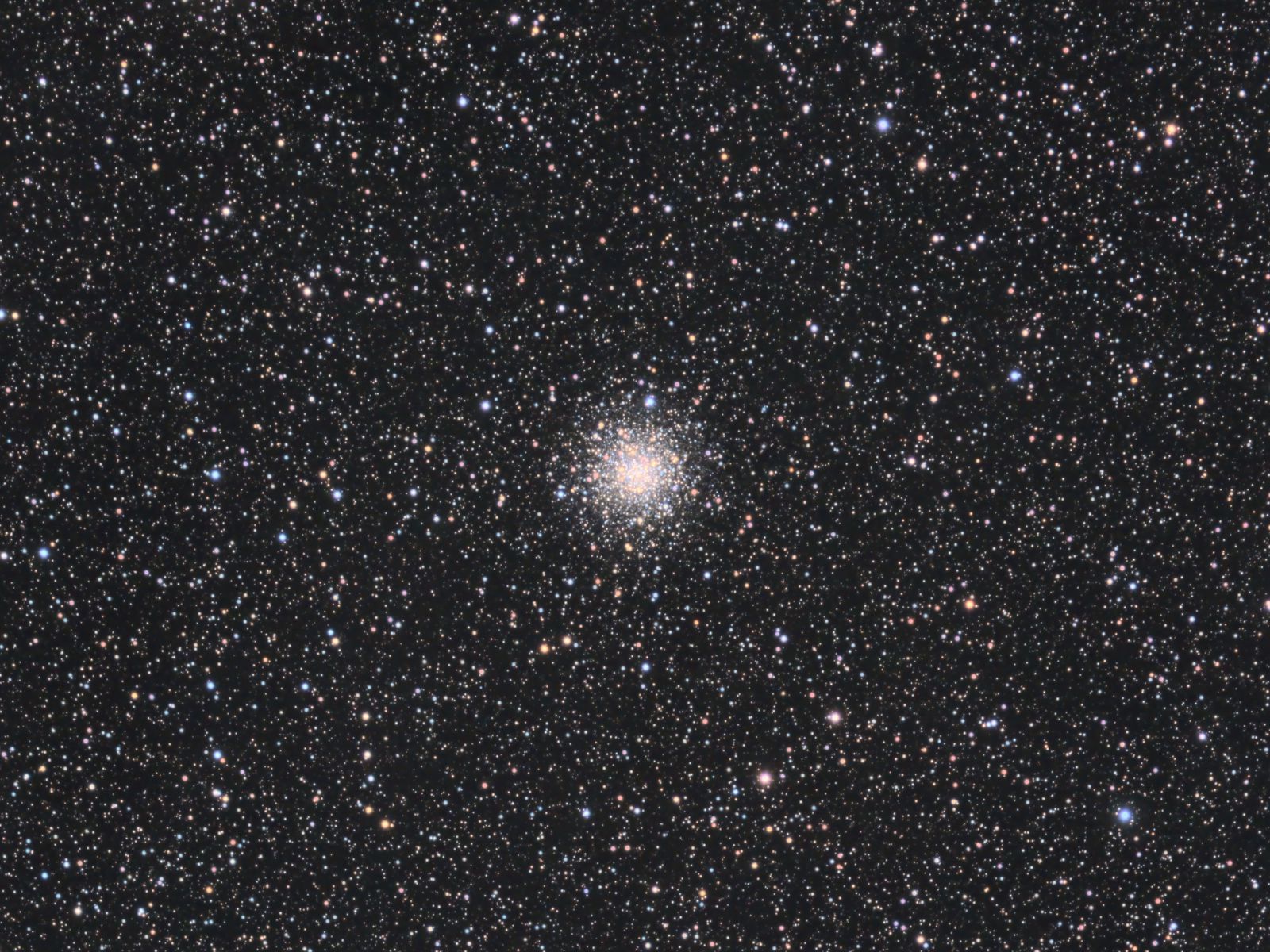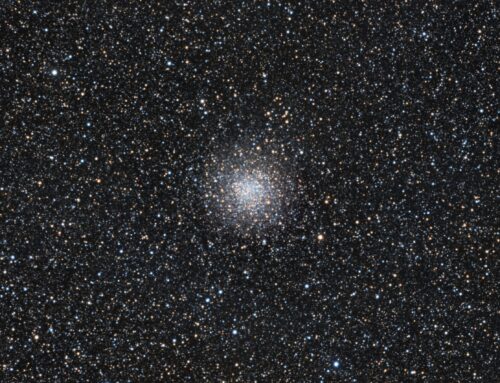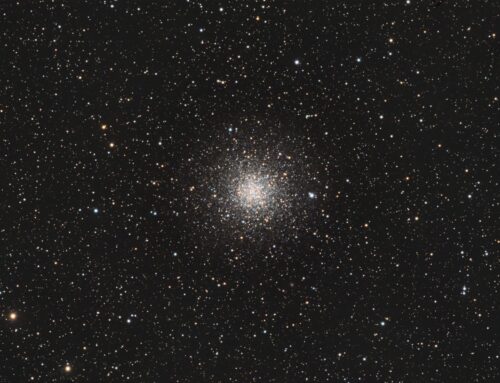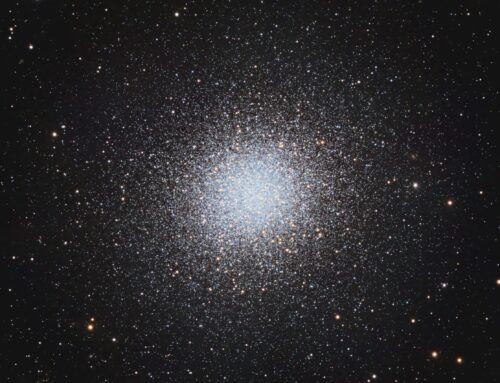M56 Globular Cluster (2020)
 Click image for full size version
Click image for full size version
May 10, 2020
Globular cluster M56, in Lyra, the Harp, lies about 33,000 light years away and its stars have the mass of about 230,000 times that of the Sun. It sometimes goes unnoticed because it shares the general area of the sky with a few other iconic objects: the Ring Nebula (M57), the “Double Double” – a pair of tight, bright, white double stars – and Vega, the 5th brightest star in the sky. One of the things I like about globular clusters is how different they all are from each other. This one resolves quite well right to the core, and is set in a rich Milky Way star field. Another thing I find interesting about these objects is that they tend to be very old. This one is estimated to be 13.7 billion years old, and may have been captured by the Milky Way from another galaxy. Its orbit around the Milky Way is retrograde, meaning it is in a direction opposite to most other similar objects.
The last time I imaged this object was in May 2013. The previous version was captured with a 10″ reflector.
Tekkies:
Acquisition, focusing, guiding and control of Paramount MX mount with TheSkyX. Focus with Optec DirectSync motor and controller. Automation with CCDCommander. Equipment control with PrimaLuce Labs Eagle 3 Pro computer. All pre-processing and processing in PixInsight. Acquired from my SkyShed in Guelph. Average or better transparency and seeing. Data acquired May 7-8, 2020 under a nearly full Moon.
Luminance: Sky-Watcher Esprit 150 f/7 refractor and QHY 16200-A camera with Optolong UV/IR filter
Chrominance: Takahashi FSQ-106 ED IV @ f/3.6 and QHY367C one-shot colour camera with Optolong L-Pro filter
Chrominance: 123x 3m = 369m
Total: 11hr14m
Data Reduction and Processing
Preprocessing: The WeightedBatchPreProcessing script was used to create a Luminance master frame (from the mono camera) and a Drizzled RGB master frame (from the one-shot colour camera). MURE Denoise script was applied to Luminance master.
Gradient Removal: DBE was applied to L and RGB masters using Subtraction.
Colour
Channel Registration: To improve channel registration, the colour channels of the RGB master were extracted and aligned with StarAlignment, using Thin Plate Splines with Distortion Correction and the luminance master as the reference frame. The registered colour channels were recombined with ChannelCombination.
Colour Balancing: Colour was balanced with PhotometricColorCalibration.
Linear Noise Reduction: MultiscaleLinearTransform was used to reduce noise in the background areas, using an internal mask to protect bright structures. Layer settings for threshold and strength: Layer 1: 5.0 0.85, 2 iterations; Layer 2: 3.5, 0.75, 2 iterations.
Stretching: MaskedStretch was followed by a contrast boost with CurvesTransformation to make a pleasing, bright image, with background intensity of approximately 0.10.
Correcting Artifacts in Star Cores: To correct dark artifacts in the core of bright stars, the a* and b* channels were extracted, blurred using Convolution (SD = 2.0), and then replaced into the RGB master, using a highly stretched inverted star mask to protect smaller stars and background.
Lightness
Deconvolution: StarMask was applied with default settings to produce a Local Deringing Support Image. A clone of the image was stretched with HistogramTransformation and Curves in order to use it as a deconvolution mask. Deconvolution was applied (80 iterations, regularized Richardson-Lucy, external PSF made using PSFImage script with about 50 stars).
Linear Noise Reduction: MultiscaleLinearTransform was used to reduce noise in the background areas, using an internal mask to protect bright stars. Layer settings for threshold and strength: Layer 1: 3.0 0.75, 1 iterations; Layer 2: 2.0, 0.65, 1 iteration.
Stretching: HistogramTransformation was applied to make a pleasing, bright image, with background set to an intensity of approximately 0.10.
Combining Lightness and Colour Images
LRGB Combination: The lightness image was applied to the RGB image using LRGBCombination with default settings.
Additional Processing
Nonlinear Noise Reduction: TGVDenoise was used in L*a*b* mode to reduce noise with a mask used to target the background areas and protect the stars (max. 1,000 iterations and convergence selected for both lightness and chrominance).
Contrast Enhancement: LocalHistogramEqualization was applied using a mask to isolate the core of the globular cluster (Kernel Radius 150, Contrast Limit 1.5 and Amount 0.75).
Sharpening: The core of the globular cluster was sharpened with a pass of MultiscaleLinearTransform (bias +0.05 on 2nd and 3rd layers, dark deringing = 0.02) with the same mast as was used for the previous step.
Final Steps: Background and star brightness, contrast, and colour saturation were adjusted in several iterations using CurvesTransformation with masks as required. ICCProfileTransformation (sRGB IEC61966-2.1; Relative Colorimetric with black point compensation) was applied prior to saving as a jpg.






Leave A Comment